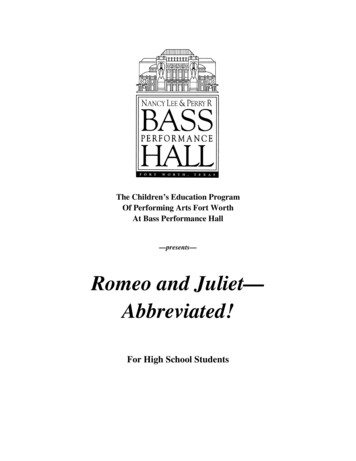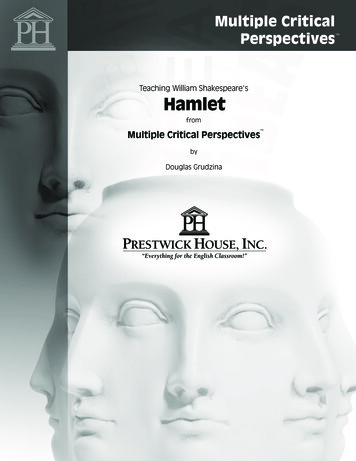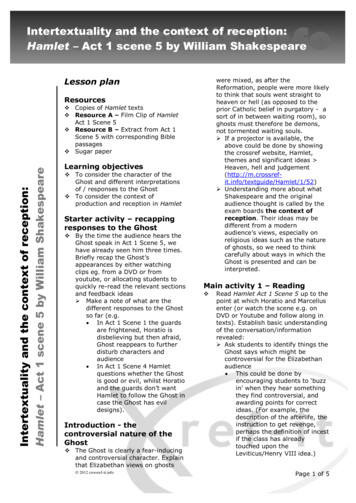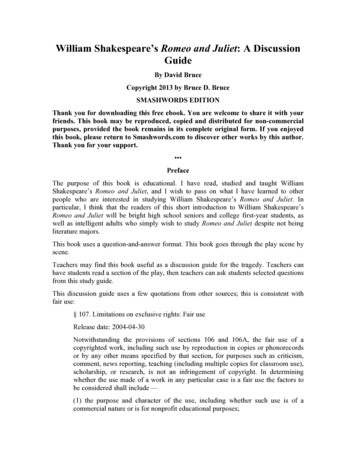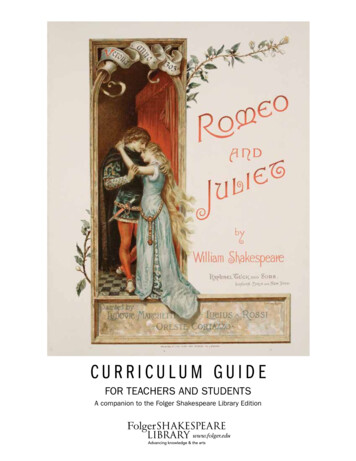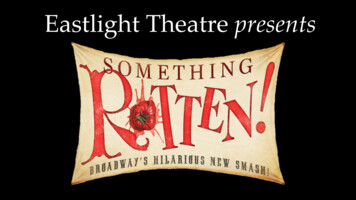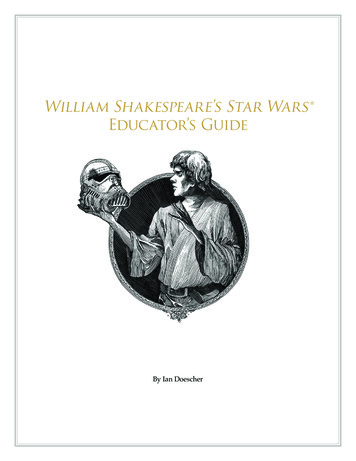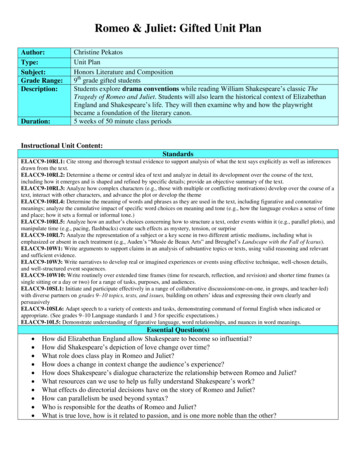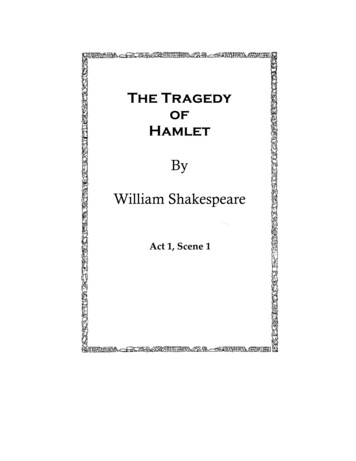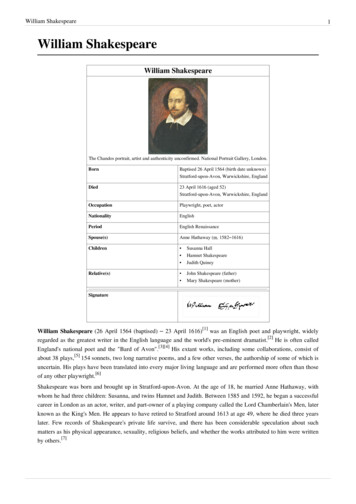
Transcription
William Shakespeare1William ShakespeareWilliam ShakespeareThe Chandos portrait, artist and authenticity unconfirmed. National Portrait Gallery, London.BornBaptised 26 April 1564 (birth date unknown)Stratford-upon-Avon, Warwickshire, EnglandDied23 April 1616 (aged 52)Stratford-upon-Avon, Warwickshire, EnglandOccupationPlaywright, poet, actorNationalityEnglishPeriodEnglish RenaissanceSpouse(s)Anne Hathaway (m. 1582–1616)Children Susanna HallHamnet Shakespeare Judith Quiney John Shakespeare (father)Mary Shakespeare (mother)Relative(s)SignatureWilliam Shakespeare (26 April 1564 (baptised) – 23 April 1616)[1] was an English poet and playwright, widelyregarded as the greatest writer in the English language and the world's pre-eminent dramatist.[2] He is often calledEngland's national poet and the "Bard of Avon".[3][4] His extant works, including some collaborations, consist ofabout 38 plays,[5] 154 sonnets, two long narrative poems, and a few other verses, the authorship of some of which isuncertain. His plays have been translated into every major living language and are performed more often than thoseof any other playwright.[6]Shakespeare was born and brought up in Stratford-upon-Avon. At the age of 18, he married Anne Hathaway, withwhom he had three children: Susanna, and twins Hamnet and Judith. Between 1585 and 1592, he began a successfulcareer in London as an actor, writer, and part-owner of a playing company called the Lord Chamberlain's Men, laterknown as the King's Men. He appears to have retired to Stratford around 1613 at age 49, where he died three yearslater. Few records of Shakespeare's private life survive, and there has been considerable speculation about suchmatters as his physical appearance, sexuality, religious beliefs, and whether the works attributed to him were writtenby others.[7]
William ShakespeareShakespeare produced most of his known work between 1589 and 1613.[8][9] His early plays were mainly comediesand histories, genres he raised to the peak of sophistication and artistry by the end of the 16th century. He then wrotemainly tragedies until about 1608, including Hamlet, King Lear, Othello, and Macbeth, considered some of the finestworks in the English language. In his last phase, he wrote tragicomedies, also known as romances, and collaboratedwith other playwrights.Many of his plays were published in editions of varying quality and accuracy during his lifetime. In 1623, JohnHeminges and Henry Condell, two friends and fellow actors of Shakespeare, published the First Folio, a collectededition of his dramatic works that included all but two of the plays now recognised as Shakespeare's. It was prefacedwith a poem by Ben Jonson, in which Shakespeare is hailed, presciently, as "not of an age, but for all time."[10]Shakespeare was a respected poet and playwright in his own day, but his reputation did not rise to its present heightsuntil the 19th century. The Romantics, in particular, acclaimed Shakespeare's genius, and the Victorians worshippedShakespeare with a reverence that George Bernard Shaw called "bardolatry".[11] In the 20th century, his work wasrepeatedly adopted and rediscovered by new movements in scholarship and performance. His plays remain highlypopular today and are constantly studied, performed, and reinterpreted in diverse cultural and political contextsthroughout the world.LifeEarly lifeWilliam Shakespeare was the son of John Shakespeare, an alderman and a successful glover originally fromSnitterfield, and Mary Arden, the daughter of an affluent landowning farmer.[12] He was born inStratford-upon-Avon and baptised there on 26 April 1564. His actual date of birth remains unknown, but istraditionally observed on 23 April, Saint George's Day.[13] This date, which can be traced back to an 18th-centuryscholar's mistake, has proved appealing to biographers, since Shakespeare died 23 April 1616.[14] He was the thirdchild of eight and the eldest surviving son.[15]Although no attendance records for the period survive, most biographers agree that Shakespeare was probablyeducated at the King's New School in Stratford,[16] a free school chartered in 1553,[17] about a quarter-mile from hishome. Grammar schools varied in quality during the Elizabethan era, but grammar school curricula were largelysimilar, the basic Latin text was standardised by royal decree,[18] and the school would have provided an intensiveeducation in grammar based upon Latin classical authors.[19]At the age of 18, Shakespeare married the 26-year-old Anne Hathaway.The consistory court of the Diocese of Worcester issued a marriagelicence on 27 November 1582. The next day two of Hathaway'sneighbours posted bonds guaranteeing that no lawful claims impededthe marriage.[20] The ceremony may have been arranged in some haste,since the Worcester chancellor allowed the marriage banns to be readonce instead of the usual three times,[21] and six months after theJohn Shakespeare's house, believed to bemarriage Anne gave birth to a daughter, Susanna, baptised 26 MayShakespeare's birthplace, in Stratford-upon-Avon.1583.[22] Twins, son Hamnet and daughter Judith, followed almost twoyears later and were baptised 2 February 1585.[23] Hamnet died of unknown causes at the age of 11 and was buried11 August 1596.[24]After the birth of the twins, Shakespeare left few historical traces until he is mentioned as part of the London theatrescene in 1592. The exception is the appearance of his name in the 'complaints bill' of a law case before the Queen'sBench court at Westminster dated Michaelmas Term 1588 and 9 October 1589.[25] Scholars refer to the years2
William Shakespeare3between 1585 and 1592 as Shakespeare's "lost years".[26] Biographers attempting to account for this period havereported many apocryphal stories. Nicholas Rowe, Shakespeare’s first biographer, recounted a Stratford legend thatShakespeare fled the town for London to escape prosecution for deer poaching in the estate of local squire ThomasLucy. Shakespeare is also supposed to have taken his revenge on Lucy by writing a scurrilous ballad about him.[27]Another 18th-century story has Shakespeare starting his theatrical career minding the horses of theatre patrons inLondon.[28] John Aubrey reported that Shakespeare had been a country schoolmaster.[29] Some 20th-century scholarshave suggested that Shakespeare may have been employed as a schoolmaster by Alexander Hoghton of Lancashire, aCatholic landowner who named a certain "William Shakeshafte" in his will.[30] Little evidence substantiates suchstories other than hearsay collected after his death, and Shakeshafte was a common name in the Lancashire area.[31]London and theatrical career"All the world's a stage,and all the men and women merely players:they have their exits and their entrances;and one man in his time plays many parts."[32]—As You Like It, Act II, Scene 7, 139–42It is not known exactly when Shakespeare began writing, but contemporary allusions and records of performancesshow that several of his plays were on the London stage by 1592.[33] By then, he was sufficiently well known inLondon to be attacked in print by the playwright Robert Greene in his Groats-Worth of Wit:.there is an upstart Crow, beautified with our feathers, that with his Tiger's heart wrapped in a Player'shide, supposes he is as well able to bombast out a blank verse as the best of you: and being an absoluteJohannes factotum, is in his own conceit the only Shake-scene in a country.[34]Scholars differ on the exact meaning of these words,[35] but most agree that Greene is accusing Shakespeare ofreaching above his rank in trying to match university-educated writers such as Christopher Marlowe, Thomas Nasheand Greene himself (the "university wits").[36] The italicised phrase parodying the line "Oh, tiger's heart wrapped in awoman's hide" from Shakespeare's Henry VI, Part 3, along with the pun "Shake-scene", identifies Shakespeare asGreene's target. Here Johannes Factotum—"Jack of all trades"— means a second-rate tinkerer with the work ofothers, rather than the more common "universal genius".[35][37]Greene's attack is the earliest surviving mention of Shakespeare’s career in the theatre. Biographers suggest that hiscareer may have begun any time from the mid-1580s to just before Greene's remarks.[38] From 1594, Shakespeare'splays were performed by only the Lord Chamberlain's Men, a company owned by a group of players, includingShakespeare, that soon became the leading playing company in London.[39] After the death of Queen Elizabeth in1603, the company was awarded a royal patent by the new king, James I, and changed its name to the King'sMen.[40]In 1599, a partnership of company members built their own theatre on the south bank of the River Thames, whichthey called the Globe. In 1608, the partnership also took over the Blackfriars indoor theatre. Records ofShakespeare's property purchases and investments indicate that the company made him a wealthy man.[41] In 1597,he bought the second-largest house in Stratford, New Place, and in 1605, he invested in a share of the parish tithes inStratford.[42]Some of Shakespeare's plays were published in quarto editions from 1594. By 1598, his name had become a sellingpoint and began to appear on the title pages.[43] Shakespeare continued to act in his own and other plays after hissuccess as a playwright. The 1616 edition of Ben Jonson's Works names him on the cast lists for Every Man in HisHumour (1598) and Sejanus His Fall (1603).[44] The absence of his name from the 1605 cast list for Jonson’sVolpone is taken by some scholars as a sign that his acting career was nearing its end.[45] The First Folio of 1623,however, lists Shakespeare as one of "the Principal Actors in all these Plays", some of which were first staged after
William Shakespeare4Volpone, although we cannot know for certain which roles he played.[46] In 1610, John Davies of Hereford wrotethat "good Will" played "kingly" roles.[47] In 1709, Rowe passed down a tradition that Shakespeare played the ghostof Hamlet's father.[48] Later traditions maintain that he also played Adam in As You Like It and the Chorus in HenryV,[49] though scholars doubt the sources of the information.[50]Shakespeare divided his time between London and Stratford during his career. In 1596, the year before he boughtNew Place as his family home in Stratford, Shakespeare was living in the parish of St. Helen's, Bishopsgate, north ofthe River Thames.[51] He moved across the river to Southwark by 1599, the year his company constructed the GlobeTheatre there.[52] By 1604, he had moved north of the river again, to an area north of St Paul's Cathedral with manyfine houses. There he rented rooms from a French Huguenot named Christopher Mountjoy, a maker of ladies' wigsand other headgear.[53]Later years and deathRowe was the first biographer to pass down the tradition that Shakespeare retired to Stratford some years before hisdeath.[54] It is perhaps relevant that the London public playhouses were repeatedly closed for months at a time duringthe extended outbreaks of the Plague (a total of over 60 months closure between May 1603 and February 1610),[55]which meant there was often no acting work. Retirement from all work was uncommon at that time,[56] andShakespeare continued to visit London.[54] In 1612, Shakespeare was called as a witness in Bellott v. Mountjoy, acourt case concerning the marriage settlement of Mountjoy's daughter, Mary.[57] In March 1613 he bought agatehouse in the former Blackfriars priory;[58] and from November 1614 he was in London for several weeks withhis son-in-law, John Hall.[59]After 1610, Shakespeare wrote fewer plays, and none are attributed to him after1613.[60] His last three plays were collaborations, probably with JohnFletcher,[61] who succeeded him as the house playwright for the King’s Men.[62]Shakespeare died on 23 April 1616[63] and was survived by his wife and twodaughters. Susanna had married a physician, John Hall, in 1607,[64] and Judithhad married Thomas Quiney, a vintner, two months before Shakespeare’sdeath.[65]In his will, Shakespeare left the bulk of his large estate to his elder daughterSusanna.[66] The terms instructed that she pass it down intact to "the first son ofher body".[67] The Quineys had three children, all of whom died withoutmarrying.[68] The Halls had one child, Elizabeth, who married twice but diedwithout children in 1670, ending Shakespeare’s direct line.[69] Shakespeare's willscarcely mentions his wife, Anne, who was probably entitled to one third of hisestate automatically.[70] He did make a point, however, of leaving her "mysecond best bed", a bequest that has led to much speculation.[71] Some scholarssee the bequest as an insult to Anne, whereas others believe that the second-bestbed would have been the matrimonial bed and therefore rich in significance.[72]Shakespeare's funerary monument inStratford-upon-Avon.of the church in 2008:[74]Shakespeare was buried in the chancel of the Holy Trinity Church two days afterhis death.[73] The epitaph carved into the stone slab covering his grave includes acurse against moving his bones, which was carefully avoided during restoration
William Shakespeare5Good frend for Iesvs sake forbeare,To digg the dvst encloased heare.Bleste be ye man yt spares thes cb4-QINUmybones.(Modern spelling: Good friend, for Jesus' sake forbear, To dig thedust enclosed here. Blessed be the man that spares these stones, Andcursed be he that moves my bones.)Shakespeare's graveSometime before 1623, a funerary monument was erected in hismemory on the north wall, with a half-effigy of him in the act ofwriting. Its plaque compares him to Nestor, Socrates, and Virgil.[75] In 1623, in conjunction with the publication ofthe First Folio, the Droeshout engraving was published.[76]Shakespeare has been commemorated in many statues and memorials around the world, including funeralmonuments in Southwark Cathedral and Poets' Corner in Westminster Abbey.PlaysMost playwrights of the period typically collaborated with others at some point, and critics agree that Shakespearedid the same, mostly early and late in his career.[77] Some attributions, such as Titus Andronicus and the early historyplays, remain controversial, while The Two Noble Kinsmen and the lost Cardenio have well-attested contemporarydocumentation. Textual evidence also supports the view that several of the plays were revised by other writers aftertheir original composition.The first recorded works of Shakespeare are Richard III and the three parts of Henry VI, written in the early 1590sduring a vogue for historical drama. Shakespeare's plays are difficult to date, however,[78] and studies of the textssuggest that Titus Andronicus, The Comedy of Errors, The Taming of the Shrew and The Two Gentlemen of Veronamay also belong to Shakespeare’s earliest period.[79] His first histories, which draw heavily on the 1587 edition ofRaphael Holinshed's Chronicles of England, Scotland, and Ireland,[80] dramatise the destructive results of weak orcorrupt rule and have been interpreted as a justification for the origins of the Tudor dynasty.[81] The early plays wereinfluenced by the works of other Elizabethan dramatists, especially Thomas Kyd and Christopher Marlowe, by thetraditions of medieval drama, and by the plays of Seneca.[82] The Comedy of Errors was also based on classicalmodels, but no source for The Taming of the Shrew has been found, though it is related to a separate play of the samename and may have derived from a folk story.[83] Like The Two Gentlemen of Verona, in which two friends appearto approve of rape,[84] the Shrew's story of the taming of a woman's independent spirit by a man sometimes troublesmodern critics and directors.[85]Oberon, Titania and Puck with Fairies Dancing.By William Blake, c. 1786. Tate Britain.Shakespeare's early classical and Italianate comedies, containing tightdouble plots and precise comic sequences, give way in the mid-1590sto the romantic atmosphere of his greatest comedies.[86] A MidsummerNight's Dream is a witty mixture of romance, fairy magic, and comiclowlife scenes.[87] Shakespeare's next comedy, the equally romanticMerchant of Venice, contains a portrayal of the vengeful Jewishmoneylender Shylock, which reflects Elizabethan views but mayappear derogatory to modern audiences.[88] The wit and wordplay ofMuch Ado About Nothing,[89] the charming rural setting of As You LikeIt, and the lively merrymaking of Twelfth Night complete
William ShakespeareShakespeare's sequence of great comedies.[90] After the lyrical Richard II, written almost entirely in verse,Shakespeare introduced prose comedy into the histories of the late 1590s, Henry IV, parts 1 and 2, and Henry V. Hischaracters become more complex and tender as he switches deftly between comic and serious scenes, prose andpoetry, and achieves the narrative variety of his mature work.[91] This period begins and ends with two tragedies:Romeo and Juliet, the famous romantic tragedy of sexually charged adolescence, love, and death;[92] and JuliusCaesar—based on Sir Thomas North's 1579 translation of Plutarch's Parallel Lives—which introduced a new kind ofdrama.[93] According to Shakespearean scholar James Shapiro, in Julius Caesar "the various strands of politics,character, inwardness, contemporary events, even Shakespeare's own reflections on the act of writing, began toinfuse each other".[94]In the early 17th century, Shakespeare wrote the so-called "problemplays" Measure for Measure, Troilus and Cressida, and All's Well ThatEnds Well and a number of his best known tragedies.[95] Many criticsbelieve that Shakespeare's greatest tragedies represent the peak of hisart. The titular hero of one of Shakespeare's most famous tragedies,Hamlet, has probably been discussed more than any otherShakespearean character, especially for his famous soliloquy whichbegins "To be or not to be; that is the question".[96] Unlike theintroverted Hamlet, whose fatal flaw is hesitation, the heroes of theHamlet, Horatio, Marcellus, and the Ghost oftragedies that followed, Othello and King Lear, are undone by hastyHamlet's Father. Henry Fuseli, 1780–5.errors of judgement.[97] The plots of Shakespeare's tragedies oftenKunsthaus Zürich.hinge on such fatal errors or flaws, which overturn order and destroythe hero and those he loves.[98] In Othello, the villain Iago stokesOthello's sexual jealousy to the point where he murders the innocent wife who loves him.[99] In King Lear, the oldking commits the tragic error of giving up his powers, initiating the events which lead to the torture and blinding ofthe Earl of Gloucester and the murder of Lear's youngest daughter Cordelia. According to the critic Frank Kermode,"the play offers neither its good characters nor its audience any relief from its cruelty".[100] In Macbeth, the shortestand most compressed of Shakespeare's tragedies,[101] uncontrollable ambition incites Macbeth and his wife, LadyMacbeth, to murder the rightful king and usurp the throne, until their own guilt destroys them in turn.[102] In thisplay, Shakespeare adds a supernatural element to the tragic structure. His last major tragedies, Antony and Cleopatraand Coriolanus, contain some of Shakespeare's finest poetry and were considered his most successful tragedies bythe poet and critic T. S. Eliot.[103]In his final period, Shakespeare turned to romance or tragicomedy and completed three more major plays:Cymbeline, The Winter's Tale and The Tempest, as well as the collaboration, Pericles, Prince of Tyre. Less bleakthan the tragedies, these four plays are graver in tone than the comedies of the 1590s, but they end withreconciliation and the forgiveness of potentially tragic errors.[104] Some commentators have seen this change inmood as evidence of a more serene view of life on Shakespeare's part, but it may merely reflect the theatrical fashionof the day.[105] Shakespeare collaborated on two further surviving plays, Henry VIII and The Two Noble Kinsmen,probably with John Fletcher.[106]PerformancesIt is not clear for which companies Shakespeare wrote his early plays. The title page of the 1594 edition of TitusAndronicus reveals that the play had been acted by three different troupes.[107] After the plagues of 1592–3,Shakespeare's plays were performed by his own company at The Theatre and the Curtain in Shoreditch, north of theThames.[108] Londoners flocked there to see the first part of Henry IV, Leonard Digges recording, "Let but Falstaffcome, Hal, Poins, the rest.and you scarce shall have a room".[109] When the company found themselves in disputewith their landlord, they pulled The Theatre down and used the timbers to construct the Globe Theatre, the first6
William Shakespeare7playhouse built by actors for actors, on the south bank of the Thames at Southwark.[110] The Globe opened inautumn 1599, with Julius Caesar one of the first plays staged. Most of Shakespeare's greatest post-1599 plays werewritten for the Globe, including Hamlet, Othello and King Lear.[111]The reconstructed Globe Theatre, London.After the Lord Chamberlain's Men were renamed the King's Men in1603, they entered a special relationship with the new King James.Although the performance records are patchy, the King's Menperformed seven of Shakespeare's plays at court between 1 November1604 and 31 October 1605, including two performances of TheMerchant of Venice.[112] After 1608, they performed at the indoorBlackfriars Theatre during the winter and the Globe during thesummer.[113] The indoor setting, combined with the Jacobean fashionfor lavishly staged masques, allowed Shakespeare to introduce moreelaborate stage devices. In Cymbeline, for example, Jupiter descends"in thunder and lightning, sitting upon an eagle: he throws athunderbolt. The ghosts fall on their knees."[114]The actors in Shakespeare's company included the famous Richard Burbage, William Kempe, Henry Condell andJohn Heminges. Burbage played the leading role in the first performances of many of Shakespeare's plays, includingRichard III, Hamlet, Othello, and King Lear.[115] The popular comic actor Will Kempe played the servant Peter inRomeo and Juliet and Dogberry in Much Ado About Nothing, among other characters.[116] He was replaced aroundthe turn of the 16th century by Robert Armin, who played roles such as Touchstone in As You Like It and the fool inKing Lear.[117] In 1613, Sir Henry Wotton recorded that Henry VIII "was set forth with many extraordinarycircumstances of pomp and ceremony".[] On 29 June, however, a cannon set fire to the thatch of the Globe andburned the theatre to the ground, an event which pinpoints the date of a Shakespeare play with rare precision.[]Textual sourcesIn 1623, John Heminges and Henry Condell, two of Shakespeare'sfriends from the King's Men, published the First Folio, a collectededition of Shakespeare's plays. It contained 36 texts, including 18printed for the first time.[118] Many of the plays had already appearedin quarto versions—flimsy books made from sheets of paper foldedtwice to make four leaves.[] No evidence suggests that Shakespeareapproved these editions, which the First Folio describes as "stol'n andsurreptitious copies".[119] Alfred Pollard termed some of them "badquartos" because of their adapted, paraphrased or garbled texts, whichmay in places have been reconstructed from memory.[120] Whereseveral versions of a play survive, each differs from the other. Thedifferences may stem from copying or printing errors, from notes byactors or audience members, or from Shakespeare's own papers.[121] Insome cases, for example Hamlet, Troilus and Cressida and Othello,Shakespeare could have revised the texts between the quarto and folioeditions. In the case of King Lear, however, while most modernadditions do conflate them, the 1623 folio version is so different fromthe 1608 quarto, that the Oxford Shakespeare prints them both, arguingthat they cannot be conflated without confusion.[122]Title page of the First Folio, 1623. Copperengraving of Shakespeare by Martin Droeshout.
William Shakespeare8PoemsIn 1593 and 1594, when the theatres were closed because of plague, Shakespeare published two narrative poems onerotic themes, Venus and Adonis and The Rape of Lucrece. He dedicated them to Henry Wriothesley, Earl ofSouthampton. In Venus and Adonis, an innocent Adonis rejects the sexual advances of Venus; while in The Rape ofLucrece, the virtuous wife Lucrece is raped by the lustful Tarquin.[123] Influenced by Ovid's Metamorphoses,[124] thepoems show the guilt and moral confusion that result from uncontrolled lust.[125] Both proved popular and wereoften reprinted during Shakespeare's lifetime. A third narrative poem, A Lover's Complaint, in which a young womanlaments her seduction by a persuasive suitor, was printed in the first edition of the Sonnets in 1609. Most scholarsnow accept that Shakespeare wrote A Lover's Complaint. Critics consider that its fine qualities are marred by leadeneffects.[126] The Phoenix and the Turtle, printed in Robert Chester's 1601 Love's Martyr, mourns the deaths of thelegendary phoenix and his lover, the faithful turtle dove. In 1599, two early drafts of sonnets 138 and 144 appearedin The Passionate Pilgrim, published under Shakespeare's name but without his permission.[127]SonnetsTitle page from 1609 edition ofShake-Speares Sonnets.Published in 1609, the Sonnets were the last of Shakespeare's non-dramaticworks to be printed. Scholars are not certain when each of the 154 sonnets wascomposed, but evidence suggests that Shakespeare wrote sonnets throughout hiscareer for a private readership.[128] Even before the two unauthorised sonnetsappeared in The Passionate Pilgrim in 1599, Francis Meres had referred in 1598to Shakespeare's "sugred Sonnets among his private friends".[129] Few analystsbelieve that the published collection follows Shakespeare's intendedsequence.[130] He seems to have planned two contrasting series: one aboutuncontrollable lust for a married woman of dark complexion (the "dark lady"),and one about conflicted love for a fair young man (the "fair youth"). It remainsunclear if these figures represent real individuals, or if the authorial "I" whoaddresses them represents Shakespeare himself, though Wordsworth believedthat with the sonnets "Shakespeare unlocked his heart".[131]"Shall I compare thee to a summer's day?Thou art more lovely and more temperate."[132]—Lines from Shakespeare's Sonnet 18.The 1609 edition was dedicated to a "Mr. W.H.", credited as "the only begetter" of the poems. It is not knownwhether this was written by Shakespeare himself or by the publisher, Thomas Thorpe, whose initials appear at thefoot of the dedication page; nor is it known who Mr. W.H. was, despite numerous theories, or whether Shakespeareeven authorised the publication.[133] Critics praise the Sonnets as a profound meditation on the nature of love, sexualpassion, procreation, death, and time.[134]StyleShakespeare's first plays were written in the conventional style of the day. He wrote them in a stylised language thatdoes not always spring naturally from the needs of the characters or the drama.[135] The poetry depends on extended,sometimes elaborate metaphors and conceits, and the language is often rhetorical—written for actors to declaimrather than speak. The grand speeches in Titus Andronicus, in the view of some critics, often hold up the action, forexample; and the verse in The Two Gentlemen of Verona has been described as stilted.[136]Soon, however, Shakespeare began to adapt the traditional styles to his own purposes. The opening soliloquy ofRichard III has its roots in the self-declaration of Vice in medieval drama. At the same time, Richard’s vivid
William Shakespeare9self-awareness looks forward to the soliloquies of Shakespeare's mature plays.[137] No single play marks a changefrom the traditional to the freer style. Shakespeare combined the two throughout his career, with Romeo and Julietperhaps the best example of the mixing of the styles.[138] By the time of Romeo and Juliet, Richard II, and AMidsummer Night's Dream in the mid-1590s, Shakespeare had begun to write a more natural poetry. He increasinglytuned his metaphors and images to the needs of the drama itself.Shakespeare's standard poetic form was blank verse, composed iniambic pentameter. In practice, this meant that his verse was usuallyunrhymed and consisted of ten syllables to a line, spoken with a stresson every second syllable. The blank verse of his early plays is quitedifferent from that of his later ones. It is often beautiful, but itssentences tend to start, pause, and finish at the end of lines, with therisk of monotony.[139] Once Shakespeare mastered traditional blankverse, he began to interrupt and vary its flow. This technique releasesthe new power and flexibility of the poetry in plays such as JuliusCaesar and Hamlet. Shakespeare uses it, for example, to convey theturmoil in Hamlet's mind:[140]Sir, in my heart there was a kind of fightingPity by William Blake, 1795, Tate Britain, is anillustration of two similes in Macbeth: "And pity,like a naked new-born babe, / Striding the blast,or heaven's cherubim, hors'd / Upon the sightlesscouriers of the air".That would not let me sleep. Methought I layWorse than the mutines in the bilboes. Rashly—And prais'd be rashness for it—let us knowOur indiscretion sometimes serves us well.Hamlet, Act 5, Scene 2, 4–8[140]After Hamlet, Shakespeare varied his poetic style further, particularly in the more emotional passages of the latetragedies. The literary critic A. C. Bradley described this style as "more concentrated, rapid, varied, and, inconstruction, less regular, not seldom twisted or elliptical".[141] In the last phase of his career, Shakespeare adoptedmany techniques to achieve these effects. These incl
Mary Shakespeare (mother) Signature William Shakespeare (26 April 1564 (baptised) – 23 April 1616)[1] was an English poet and playwright, widely regarded as the greatest writer in the English language and the world's pre-eminent dramatist.[2] He is oft
